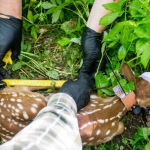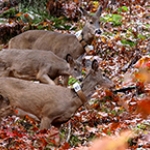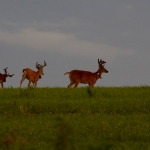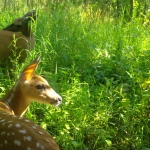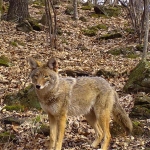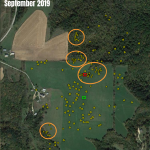Field Notes Newsletter Index
Read more about the Southwest Wisconsin CWD, Deer and Predator Study in this newsletter! The newsletter covers fieldwork, the project's status and the many researchers involved, from DNR scientists to the U.S. Geological Survey. CWD is a complex disease and topic, so some editions also cover the many research studies stemming from the Southwest Wisconsin CWD project. New editions are released every few months.
Want to get notified when new newsletters come out? Sign up for the following topics on GovDelivery.
- Chronic Wasting Disease Updates - For emails about new project newsletters
- Wisconsin Deer Research - For email updates on all deer projects being done by the Office of Applied Science
RECENT NEWSLETTERS
OCTOBER 2025
In this edition of the Field Notes newsletter, we share results of a recent survey sent to subscribers and answer some frequently asked questions. We also dive into a new publication that utilized data from the Southwest Wisconsin CWD, Deer and Predator Study to examine how white-tailed deer habitat use changes seasonally and what that might mean for CWD transmission. And finally, we share some big news about national recognition for our work.
JUNE 2025
In this issue of the Field Notes Newsletter, we seek to answer a common question: How do we know a deer died of Chronic Wasting Disease (CWD) specifically? By looking at three case examples of deer from the Southwest Wisconsin CWD, Deer and Predator Study, we aim to illustrate how CWD impacts deer health and ultimately leads to death.
JANUARY 2025
Over 1,200 animals were collared, and an unprecedented amount of data was collected, and countless hours were spent analyzing. In this edition of the Field Notes Newsletter, we announce the primary results of the Southwest Wisconsin CWD, Deer and Predator Study. While additional findings will be announced as they become available, here, we will break down each of the study's primary objectives and their corresponding results here.
SEPTEMBER 2024
Data from over 1,200 GPS collars on deer, coyotes and bobcats is being analyzed, and some results have been published. This edition of Field Notes will be of interest to hunters prepping for fall hunts: videos of deer movement and interactions during peak rut. We'll begin with an overview of 11 deer in a small study area section. Then, we'll dive into individual bucks from that area, looking at the interactions between two mature bucks and one of those bucks' disjointed seasonal home range.
DECEMBER 2023
Where do bucks go during a rut? Matt Hunsaker conducted his master's thesis to find that answer, studying buck movement ecology during the breeding season and determining when peak rut occurs. Follow a buck Matt tracked through three breeding seasons. We also caught up with Dr. Daniel Walsh, Unit Leader at the USGS Montana Cooperative Wildlife Research Unit, who talked about his big hopes for the project's impact.
JULY 2023
CWD is persistent in the environment, which begs the question: What are all the ways that deer can come in contact with CWD? UW-Madison researcher Dr. Heather N'te Inzalaco decided to think outside the box in her investigation into the landscape and community-level factors of CWD transmission. We also introduce you to our collaborator, Dr. Wendy Turner, who leads the UW-Madison team, helping analyze the data we collected and build the IPM. Turner is a wildlife disease ecologist who brings knowledge and experience from working with anthrax in southern Africa and facilitating global research projects.
NOVEMBER 2022
Dr. Marie Gilbertson shares another analysis from the GPS locations of over 1,000 deer. This time, she investigated dispersal, a period when deer venture from their birth range to establish new home ranges of their own. Gilbertson dives into the who, when, where and why to further our understanding of how Wisconsin's deer population uses the landscape and how dispersal may contribute to the spread of CWD.
APRIL 2022
The Southwest Wisconsin, CWD, Deer and Predator Study has two new analyses ready to share. The first recaps what we've learned from our evaluation of the deer that died in the research area. This analysis of necropsy reports helps us understand what diseases are afflicting the deer population in the area. The second analysis investigates fawn survival and cause-specific mortality rates, helping us better understand deer recruitment in Wisconsin.
NOVEMBER 2021
The research team is wrapping up the first few analyses from the Southwest Wisconsin CWD, Deer and Predator Study. In this newsletter edition, the team shares the results of one of these studies, the Coyote Survival and Cause-Specific Mortality study. These results give a deeper look into the lives and deaths of coyotes in southwest Wisconsin. Additionally, a new researcher recently joined the team, and she explained her role and excitement about being involved.
MAY 2021
The research team shares a new timeline for when they expect to have results for each analysis in this study. This timeline is the most precise overview to date of all that will come from the study and when each piece of the puzzle is expected to be analyzed. The team also highlights an example of the types of information they can learn from the collared animals. This story follows a buck's movement throughout the Fall of 2021.
For past newsletter editions not seen here, visit the Catalogue of Past Articles and Media.



